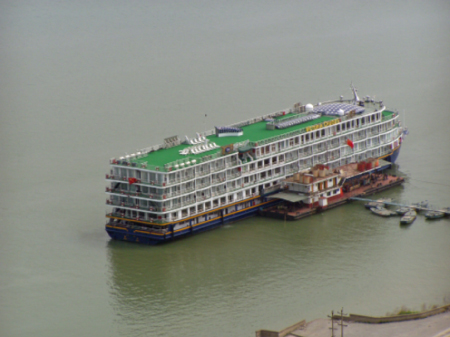THE YANGTZE RIVER
 |
 |
|
After flying to Chonquing we boarded a river boat for two days on the Yangtze River.
|
The scenery along the river is a mixture of industry,
large housing projects, and rural areas. Of course, much of it is being
flooded by the Three Gorges Dam project. |
 |
 |
|
New developments are appearing above what will be the new high water line.
|
This is Fuling, the setting for Peter Hessler's book,
River Town, an excellent book that describes the two years he
spent here as a Peace Corps volunteer. |
 |
 |
|
The afternoon of the first day we stopped at Fengdu, site
of what the guidebooks called the Ghost City, which the local guide called
the City of Hell. "Welcome to Hell." Most of us chose to take
the ski lift up, although a few decided to walk the 300 or so stone steps
to the temple complex. All of the flat land seen below the lift will be
flooded by the rising river; the town has been rebuilt on the other side
of the river. |
 |
 |
(Photo: Ed Lewins) |
|
Entering the temple involved several tests, including one that required married couples to walk over this bridge in a specified number of steps. We did it--or didn't, depending on how you counted! |
|
 |
 |
|
Running or walking up all 33 steps in one breath was supposed to bring good luck--if it didn't produce a heart attack first.
|
There were many-times-life-sized figures looming over
several areas. |
 |
 |
|
People left offerings at the Buddhist shrine.
|
The walk was a series of gates and steps leading to
the top of the mountain. |
 |
 |
|
These figures represented the three blessings: children, money, and long life.
|
There were also depictions of demons and evildoers. |
 |
 |
It is possible to buy papers that provide a kind of forgiveness for sins of oneself or one's ancestors. These are burned in order to send them into the next world. Shades of Martin Luther!
|
Our guide explained that in Buddhist thought there is no eternal Hell, only a judgment made on each soul by the King of Hell that determined what it would be reincarnated as. |
 |
 |
|
Having escaped Hell, we proceeded into the first of the Three Gorges. Of course, much of the drama of the gorges was lost when the river level rose, but it is still a beautiful area.
|
We saw the writing on the wall--a little scary for
people who had just escaped Hell. |
 |
 |
|
On the second day we transferred from the river boat to a smaller ferry to explore the "Lesser Three Gorges."
|
|
 |
 |
|
There are still small farms along the river that will need to be demolished as the water rises.
|
|
 |
 |
|
Some people still earn a living in the traditional way.
|
There were a large number of waterfalls along the route. |
 |
 |
 |
 |
|
New villages have been built to replace the one inundated by the river project. The steps give you an idea of where the eventual water level will be. The brown area on the edge represents a recent flood--controlling these floods is one of the major purposes of the Three Gorges Dam.
|
We then transferred into sampans to explore some of
the back areas of the small gorges. |
 |
 |
|
Ed and some of the others did their imitations of the Volga Boatman (or Yangtze Boatman, in this case).
|
In this area there are a number of "hanging coffins"
of the Ba people, which date from about 2500 years ago. It is not clear
how these coffins were placed there or the reason for putting them there. |
 |
 |
|
On our return to the river boat we continued our journey through the Three Gorges.
|
|
 |
 |
|
We passed a rock formation known as The Goddess Peak.
The small finger of rock standing by itself is said to represent the daughter
of the Heavenly Mother, who guided ships through the gorge. |
At the end of our river trip we disembarked. The gorge is so steep that we had to use this contraption to move from the river's edge to the road.
|
 |
 |
|
We then paid a visit to the Three Gorges Dam project,
modeled here. |
This will be a "ship elevator" that will move smaller vessels over the dam in one lift, saving them the time of going through the 5 locks that larger ships will use.
|

The dam is not the highest or the longest in the world, but it is the most massive, in terms of cubic yards of concrete. Up close, it dwarfs everything around it.